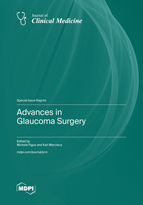Advances in Glaucoma Surgery
A special issue of Journal of Clinical Medicine (ISSN 2077-0383). This special issue belongs to the section "Ophthalmology".
Deadline for manuscript submissions: closed (20 June 2023) | Viewed by 30287
Special Issue Editors
Interests: glaucoma; cataract; ocular surface; uveitis
Special Issues, Collections and Topics in MDPI journals
Interests: glaucoma; cataract; uveitis; surgical innovation; medical education
Special Issues, Collections and Topics in MDPI journals
Special Issue Information
Dear Colleagues,
Glaucoma surgery still represents a real challenge both in terms of ensuring safety and efficacy, particularly the balance between the two. Significant technological advances have led to innovative surgeries, which in turn have been rapidly introduced into clinical practice. New devices to lower intraocular pressure show promising results, but it is still unclear whether they can replace the current ‘standard’ surgeries, such as trabeculectomy or glaucoma drainage devices. Moreover, even these standard procedures are being continuously modified in various ways in the search of better safety-efficacy outcomes. At the same time, more and more attention is being paid to the ocular surface. It is well known that glaucoma therapy-related ocular surface disease can worsen patients’ quality of life and affect the outcome of glaucoma filtration surgery. This is the reason for this Special Issue, for which we welcome manuscripts on the following topics:
- Minimally invasive glaucoma surgery;
- Non-plate, bleb-forming glaucoma devices;
- Trabeculectomy;
- Glaucoma-therapy-related ocular surface disease;
- Glaucoma drainage devices;
- Non-penetrating glaucoma surgery;
- Ciliary body function modulation;
- Selective laser trabeculoplasty.
Prof. Dr. Michele Figus
Dr. Karl Mercieca
Guest Editors
Manuscript Submission Information
Manuscripts should be submitted online at www.mdpi.com by registering and logging in to this website. Once you are registered, click here to go to the submission form. Manuscripts can be submitted until the deadline. All submissions that pass pre-check are peer-reviewed. Accepted papers will be published continuously in the journal (as soon as accepted) and will be listed together on the special issue website. Research articles, review articles as well as short communications are invited. For planned papers, a title and short abstract (about 100 words) can be sent to the Editorial Office for announcement on this website.
Submitted manuscripts should not have been published previously, nor be under consideration for publication elsewhere (except conference proceedings papers). All manuscripts are thoroughly refereed through a single-blind peer-review process. A guide for authors and other relevant information for submission of manuscripts is available on the Instructions for Authors page. Journal of Clinical Medicine is an international peer-reviewed open access semimonthly journal published by MDPI.
Please visit the Instructions for Authors page before submitting a manuscript. The Article Processing Charge (APC) for publication in this open access journal is 2600 CHF (Swiss Francs). Submitted papers should be well formatted and use good English. Authors may use MDPI's English editing service prior to publication or during author revisions.
Keywords
- glaucoma surgery
- minimally invasive glaucoma surgery
- intraocular pressure
- ocular surface
- glaucoma







